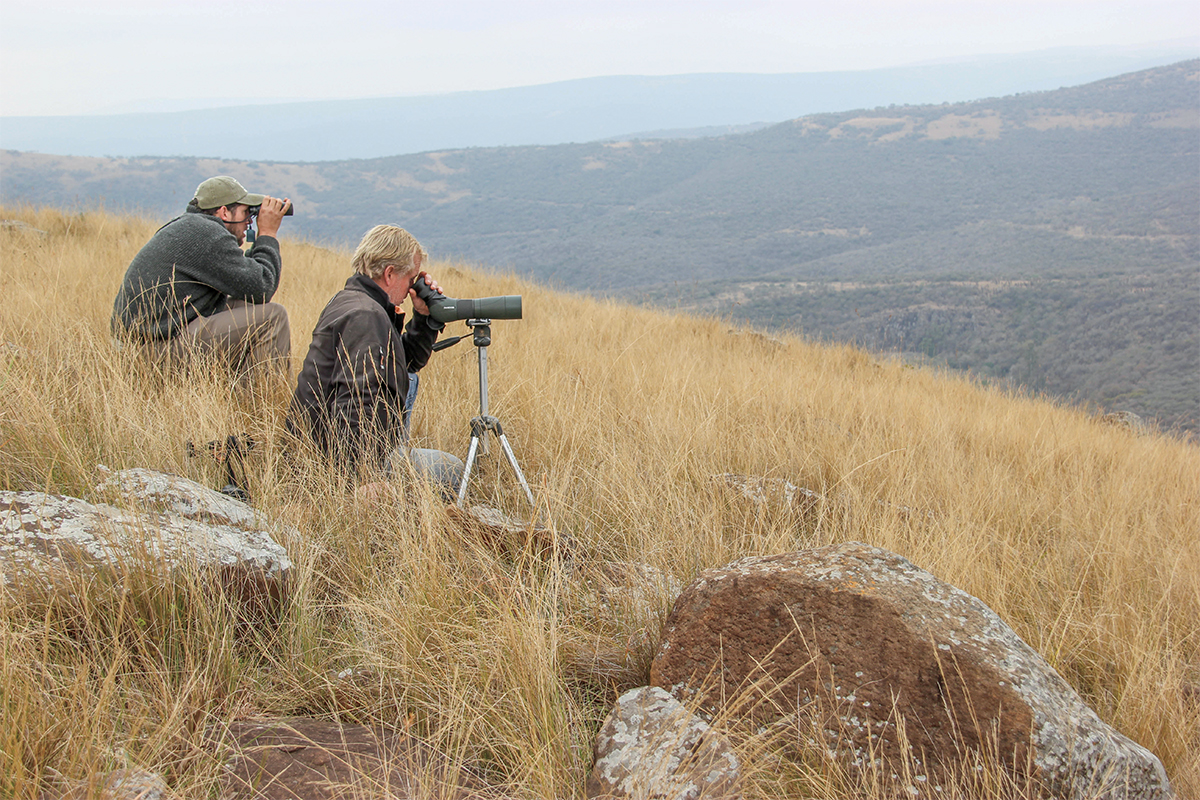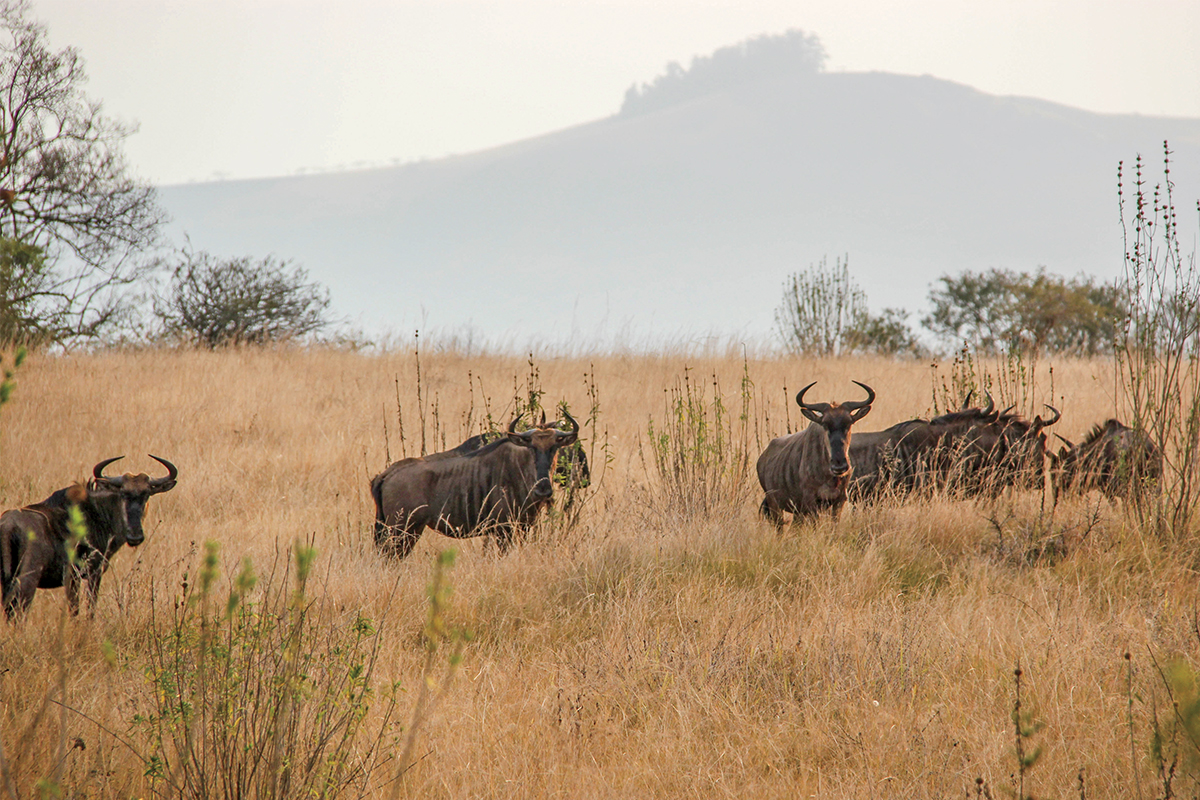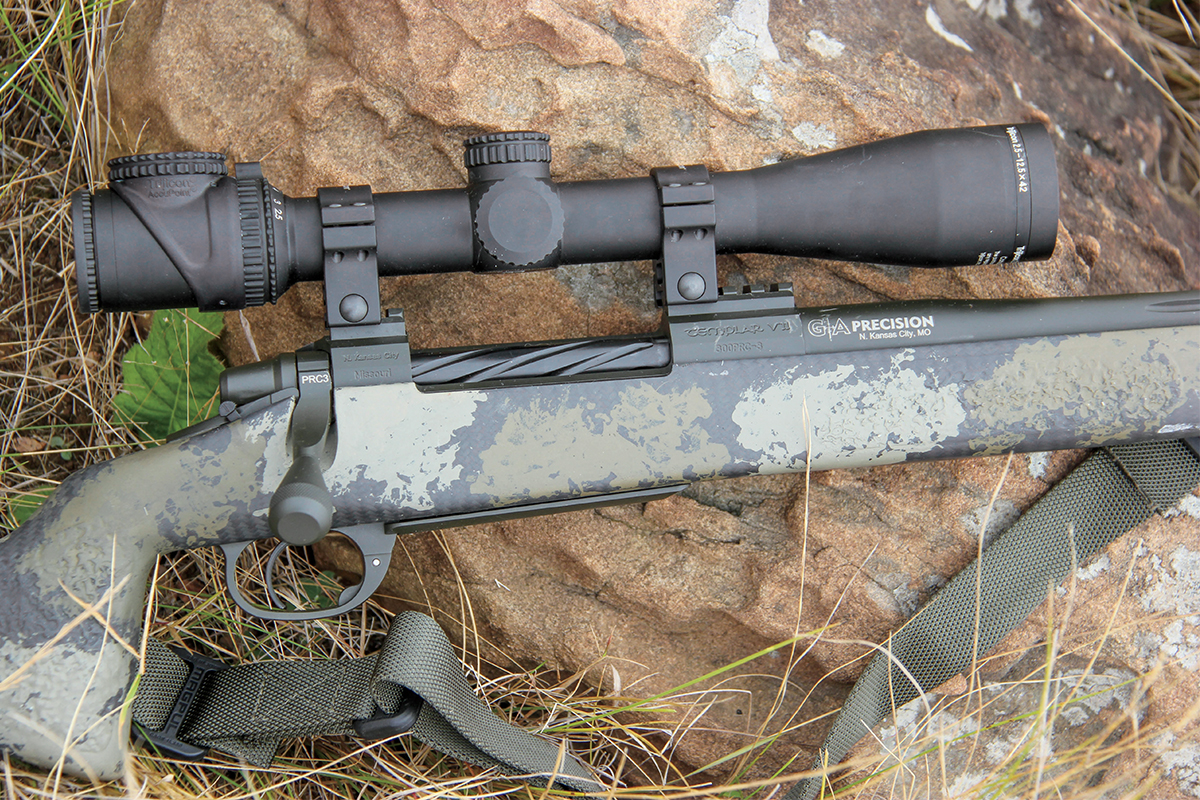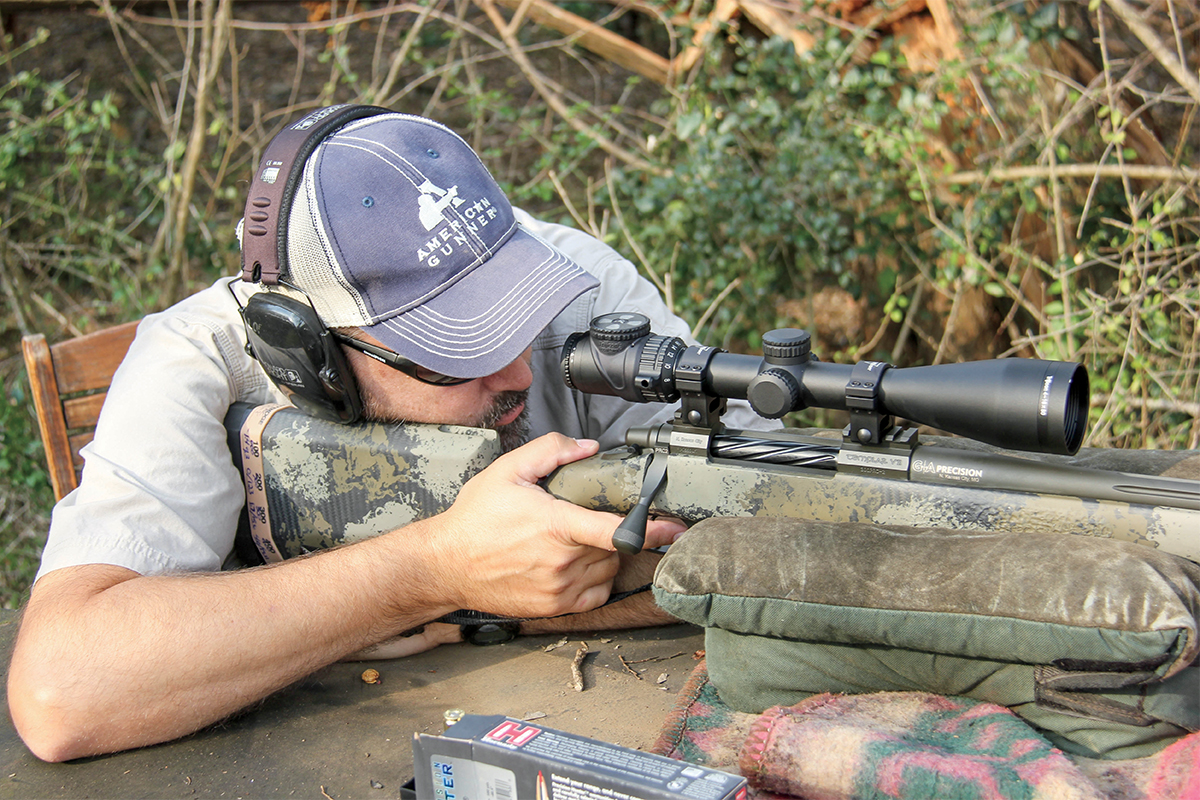
South Africa isn’t often associated with long-range hunting. Many of the game ranches in this vast country are covered with dense bush that limits shots to a couple hundred yards or less. There are exceptions, however, and the Umkomaas Valley is one of them. Located in the KwaZulu-Natal province on the eastern edge of South Africa, the Umkomaas Valley is a 120,000-acre wilderness that borders its namesake river. KwaZulu-Natal is the homeland of the Zulu people, whose warrior King Shaka developed new weapons and tactics, allowing the tribe to gain control over many of the surrounding areas stretching as far north as Mozambique and deep into the interior of South Africa. It’s been said the Zulu stopped the southward expansion of East Africa’s powerful Masai warriors—or perhaps the Masai stopped the northward expansion of the Zulu.

Our hunting party flew from Johannesburg toward the city of Durban, one of the busiest ports on Africa’s Indian coast, passing over a patchwork of agricultural fields perched on the east and west rims of the Umkomaas Valley. The valley itself is a dark, irregular scar on the landscape with high, rocky cliffs and steep slopes covered by snarled thorns. With no fences and minimal hunting, the valley is home to a wide array of endemic African antelope species including Cape bushbuck, Cape kudu, zebra, eland, duiker, and others.
There are also many warthogs, a half-dozen of which were kneeling on their forelegs and trimming the grass around Crusader Safaris’ Umkomaas Valley tented camp when we arrived. The sun was already behind the canyon rim when we began unloading our gear. Crusader Safaris owner Andrew Pringle directed me toward my own canvas tent while a baboon barked in the high rocks above us. By the time I was settled the only sounds in the valley were the hum of insects and the sloshing of the river.
Of the dozens of species of game to pursue in the Umkomaas, a big bull nyala was what I wanted most. Properly referred to as the common nyala (which doesn’t do this species justice: How could a 400-pound animal with ivory-tipped horns, striking chestnut, gray, and white markings, and a magnificent mane qualify as common?), this spiral-horned antelope exists naturally in few places in Africa, and nowhere does it exist in higher concentrations than in KwaZulu-Natal. In fact, some of the biggest nyala bulls on record were killed within a few miles of Crusader’s Umkomaas camp.
Table of Contents
The Rifle & Cartridge
By the time I arrived in South Africa in late 2018, the .300 Precision Rifle Cartridge (PRC) had been announced to the public and a handful of long-range shooters were already using the round to ring steel out past a mile. The powerful new cartridge promised good things: based on a .375 Ruger case, the .300 PRC requires a magnum bolt face, but unlike belted magnums, the full-diameter .375 Ruger case allows for substantial powder payloads. The .300 PRC headspaces off its 30-degree shoulder and chamber drawings are precise. Hornady’s initial match load pushes a 225-grain, polymer-tipped ELD Match bullet with a ballistic coefficient of .777 (G1) at 2,810 feet per second, which is nipping at the .338 Lapua’s heels.
The Lapua excels at long-range shooting, but there are only a handful of hunters that carry Lapua rifles in the field. What about the .300 PRC? I wondered if it would make a sensible all-purpose rifle, especially given the popularity of established rounds like .300 Win. Mag., .300 Weatherby Mag., and the .300 WSM. The .300 PRC hadn’t been used extensively in the field to that point. It was powerful and accurate, but was it practical? And did it offer any real advantage over older rounds?

George Gardiner at GA Precision built several early .300 PRC rifles using Templar V2 actions and I carried one of those guns in the Umkomaas. It wasn’t particularly light, with its 26-inch barrel and removable brake, but it was supremely accurate. At 100 yards the GA rifle would place three 212-grain ELD-X hunting bullets close enough to touch, and five shots under an inch was no problem. The early adopters of the .300 PRC said it was the most accurate of the .30-caliber magnums they’d shot, and I’ve found the same to be true.
I topped the rifle with a Trijicon AccuPoint 2.5-12×42 with a green illuminated reticle. For dedicated long-range testing, I would have chosen greater top-end magnification, but the Trijicon’s low 2.5x magnification was important. While I might shoot a nyala at 400 yards, a 40-yard shot through thick brush was also possible. For that, I needed the additional field of view. I also needed a scope that could withstand being bounced around in the bellies of planes, abuse from baggage handlers, and heavy recoil. The AccuPoint checked all those boxes. I double-checked my zero at 100 yards when I arrived at camp and there was no shift in point of impact.
The Nyala Trail
African winter nights can be quite cold. As dim purple light brightened the eastern horizon and the jackals yapped on the crest of the ridges, I slipped from my bed and pulled on extra layers of clothing. After coffee at the main dining patio, I met Professional Hunter Rad Robertson and together we loaded my gear into his Toyota Hilux pickup. We were hunting farther up the valley and needed an early start. The rest of the camp began to stir as we left and began climbing to the rim of the valley.

By sunrise the Hilux was bouncing through dry watercourses along the river’s edge. I’d seen a half-dozen nyala that morning, including what I thought was a particularly good bull, but one that Rad elected to pass. Nyala are creatures of habit who follow the same trails and prefer to hide in familiar patches of thorn. Late in the morning Rad and I found one trail that was particularly well-worn. We climbed through a forest of tombstone-gray eucalyptus trees and settled on a narrow hummock—an ideal glassing point. We did see several nyala cows, which are lighter in build and color than bulls, browsing along the edge of the primary trail that wound through the trees along a dry riverbed below.
It was late in the day when Rad decided to move and check a narrow bowl higher up the mountain. The higher country was much more open and if we found a bull the shot might be 400 yards or more. It wasn’t long until we saw game: A herd of dusty-gray kudu cows were browsing in the blackthorn trees halfway to the top. Their broad ears flapped as they stretched their long, thin necks up to pick the choicest leaves.
Rad, who was resting against the base of an aloe tree, told me he saw a bull. Above the cows a single dark animal moved through the knee-high, winter-dry grass. I looked at the bull through my binocular and waited in silence for Rad’s decision. When the bull started down the spine of the hill 300 yards away, Rad decided the horns measured between 25 and 26-inches. We could find a bigger bull.
We were ready to pull stakes and head back to camp for a braai when Rad told me saw another nyala. He had seen this bull before and recognized its wide, heavy horns which measured perhaps 27 inches in length, which wasn’t much better than the first. But the second bull’s horns were much wider with deeper curls and greater girth. The animal’s shaggy body was noticeably larger than the first, too.
The bull vanished into a thin band of trees and our only course of action was to drop down into the valley and slip back up the other side. With all the game scattered throughout the bowl and across the ridge it would be hard to avoid detection, but we decided to try our luck.
Grey columns of clouds pushed inland from the Indian Ocean and darkened the hills. Carefully avoiding the wait-a-bit thorns and ever vigilant for snakes in the hip-high grass we made our way up through the forest, past the kudu herd and into the trees where we’d last seen the nyala. The bull had moved and Rad spotted him just 70 yards away. I shouldered the rifle, but could plainly see a single bent branch that had been invisible to the naked eye. The branch covered the bull’s vitals, and I held my shot until the bull disappeared into the dark forest.
Minutes later we saw a bull come out along the far edge of the trees farther down the slope. Rad insisted on glassing the animal first because he didn’t want to shoot the smaller bull by accident, but soon confirmed the animal walking across the ridge below us was indeed the older bull.
With shooting sticks to stabilize the rifle and an aloe tree serving as a brace I was quite steady and could see the seam of the front leg. Holding a third of the way to the top of the shoulder I pressed the safety forward, slowed my breath, and shot.

There was a flash of orange flame from the muzzle and all I could see was a halo of light impressions dancing in my eyes. The tracker initially reported that he didn’t find any blood or signs that the nyala had been hit, which concerned me, but in the tall grass thirty yards from where the bullet struck, the bull lay stretched out dead in mid stride. Nyala are impressive animals, but being close enough to touch one offers a close look at their striking features.
The horns are deep walnut in color with semi-translucent tips and are neatly curved. White marks like warpaint dot the face (including the characteristic chevron) and the long hairs of the animal’s mane are banded in shades of black, gray, and tan. At nightfall, we headed down the mountain with my bull.
Mixed Bag
With a bit of luck and some good shooting, a hunter in the Umkomaas Valley could harvest more game in a week-long safari than most North American hunters collect in a decade. Modern safaris are a great way to experience Africa as it was in the glory days, and it’s an important means to feed a community where cattle are scarce and beef is costly (which, in turn, prevents the need for poaching).
These hunts are also a great way to test bullet performance because you have animals of varying sizes offering differing shot angles and ranges. Hornady’s Neal Emery hung around the skinning shed collecting .300 PRC ELD-X bullets from the game that he and I shot. We had a broad selection of animals, too. By the middle of the week, I’d killed a cape bushbuck ram with a high uphill shot measuring about 320 yards, and I tagged an incredibly old common reedbuck ram under almost the same conditions the following day at the far end of the valley.
On the day I killed my reedbuck, Emery shot a larger ram in the same area at about 400 yards. Interestingly, we were able to collect bullets from other hunters in camp who were using .300 Win. Mag. and .300 H&H rifles, and the .300 PRC performed well compared to those older rounds. The .300 PRC didn’t create excessive wound channels and terminal performance was superb on animals ranging from 100 to 450 pounds at distances from 50 yards to over 500 yards. We finished the safari by shooting across a canyon at distances to 1,400 yards. The .300 PRC shines as a target round, of course, and the extraordinarily accurate GA Precision rifles made hitting targets at long range no chore.

The .300 PRC is indeed a great target round, but it’s an equally adept big-game cartridge capable of taking most any game at extended ranges. I came away from the Umkomaas Valley with an appreciation not only for the forward-thinking design of the cartridge but a sincere appreciation for its outstanding versatility.
If you own a good rifle chambered in .300 PRC there’s little you can’t do with it so long as you can handle the recoil, which is substantial but manageable. Hornady makes a compelling case that they’ve developed a multi-purpose cartridge that’s perfectly suited for the shooter who wants a target gun that’s also capable of tackling big-game hunts in every corner of the globe.








































